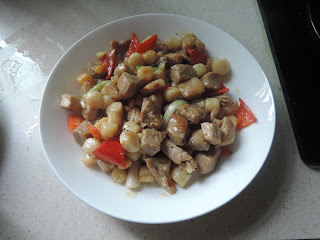Founded by David Powell in 1994, with the
roots going back to 1992 when David was working for Rockford and began to
discover and clean up a few sections of dry-grown old vines. He nurtured the
near lifeless vines back to health and got a small parcel of fruit that he made
into wine, and then he secured a contract for the supply of grapes from a
run-down but ancient Shiraz vineyard.
 He raised enough money to share-farm the
vineyard, and paid the other owner a percentage of the market rate for his
grapes in return for totally managing the vineyard. This arrangement has
enabled Torbreck to use fruit from the very best vineyards in Barossa Valley
and in 1995 he crushed 3 tonnes of grapes and fermented into wine, naming his
wine Torbreck after a forest in Scotland where he worked as a lumberjack.
He raised enough money to share-farm the
vineyard, and paid the other owner a percentage of the market rate for his
grapes in return for totally managing the vineyard. This arrangement has
enabled Torbreck to use fruit from the very best vineyards in Barossa Valley
and in 1995 he crushed 3 tonnes of grapes and fermented into wine, naming his
wine Torbreck after a forest in Scotland where he worked as a lumberjack.
Focusing on the classic varieties in the
region, including Shiraz, Grenache and Mataro, he made his wine after his love
for the Rhone style. Now Torbreck also made white wines from Viognier, Marsanne
and Roussanne. In 2002 the historic Hillside property was acquired, providing further
sources of premium quality fruit.
At the finish of the 2003 vintage, Torbreck
opened its cellar-door for sales, restoring the original settlers hut to
welcome visitors. A new winery and administration facility was added in 2008 to
allow the wines to be bottled on the estate using an in-house bottling line,
allowing the complete control of all aspects of production. In 2008 Torbreck
Vintners was acquired by Pete Kight.
The Laird refers to ‘Lord of the Manor’ in
Scottish, and the wine comes from the single vineyard of Malcolm and Joylene
Seppelt’s old Gnadenfrei vineyard in Marananga of Barossa Valley. In 2003
Malcolm asked if Torbreck would make the wine under contract for him and after
two years Torbreck got the opportunity to purchase the fruit, regarded as their
best parcel of Shiraz.
At the same time, Torbreck was approached
by Dominique Laurent to purchase their barrels, renown for the much thicker
staves used to make the barrels for long-term maturation. With all these
elements, The Laird is regarded the best Shiraz made by Torbreck.
The RunRig has often drawn comparison with
the best Cote Rotie, with the aromatic wine also showing much power and
richness often mistaken to come from Rhone. The Pict is typically associated
with the Bandol region, and this single vineyard Mataro has rich and dense
flavors that could evolve in many years to come.
The Factor is using grapes from the great
old Shiraz of the Barossa Valley and is a showcase on the quality of Barossa. Descendant
comes from the single vineyard next to Torbreck’s winery on Roennfeldt Road,
planted in 1994 with cuttings off old RunRig vineyards, it is also Barossa’s
first co-fermented Shiraz/Viognier, with the Shiraz crushed on top of Viognier,
and the wine matured for 18 months in barrels, and requiring at least 5 years
cellaring before consumption.
 The Struie comes from the cooler climate,
higher altitude of Eden Valley, blended with fruit from the powerful Barossa
Shiraz and aged for 18 months in old and new French oak prior to bottling. Woodcutter’s
Shiraz is made using open fermenter and gently basket pressed, aged for one
year in large old barrels.
The Struie comes from the cooler climate,
higher altitude of Eden Valley, blended with fruit from the powerful Barossa
Shiraz and aged for 18 months in old and new French oak prior to bottling. Woodcutter’s
Shiraz is made using open fermenter and gently basket pressed, aged for one
year in large old barrels.
The Steading is perhaps the most important
wine within the portfolio, sourced from Torbreck’s own vineyards as well as
growers, totaling 45 different sources of fruit, all vinified separately and
then blended once the individual wines were assessed.
I have recently tasted the 2006 Descendant
and below is my tasting note:
Appearance
Bright
and clear, it has deep ruby color, with fading rims and legs.
Nose
Clean, with
pronounced intensity of black fruit of blackberry and plum, red fruit of dried
strawberry, dried fruit of prune, pungent spice of licorice, oak notes of
vanilla, animal notes of meaty, maturity notes of mushroom. The wine is
developing.
Palate
Dry with
medium acidity, the wine has medium (+) tannin of ripe and velvety texture,
medium (+) alcohol and full body, demonstrating medium (+) intensity of flavors
including black fruit of blackberry and plum, dried fruit of prune, oak notes
of smoke, pungent spice of licorice, sweet spice of thyme. The wine has a
medium (+) finish.
Conclusion
Very good quality Australian Shiraz blend showing a very intense
nose of high complexity, the wine is phenomenal on the structure but having
also a finesse despite its high alcohol, with a palate that is very
concentrated and showing equally impressive complexity, as well as a long
finish. It is ready to drink now though can maintain for another 7-9 years.




















































